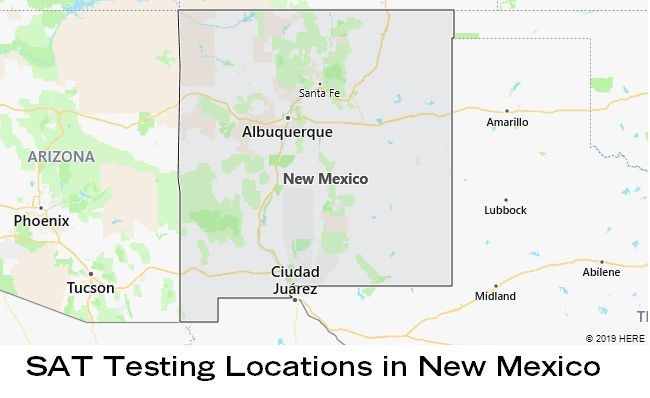According to the College Board, there are 20 test centers for SAT and SAT Subject Tests in New Mexico. Please note that before you register either of the SAT exams, you should choose your test date and test location. Each testing location is affiliated with an educational institution, such as high school, community college, or university. The following test centers administer one or more of SAT tests in New Mexico.

2019 – 2020 SAT Test Dates in New Mexico
- March 9, 2019
- May 4, 2019
- June 1, 2019
- August 24, 2019
- October 5, 2019
- November 2, 2019
- December 7, 2019
- March 14, 2020
- May 2, 2020
- June 6, 2020
- August 29, 2020
- October 3, 2020
- November 7, 2020
- December 5, 2020
SAT Testing Centers in New Mexico
ALAMOGORDO HS
ARTESIA HS
ATRISCO HERITAGE ACADEMY HIGH SCHOOL
CAPITAN HIGH SCHOOL
CLOVIS HS
EASTERN NEW MEXICO U
GALLUP CENTRAL HS
HIGHLAND HS
LAS CRUCES HS
LOS ALAMOS HS
MORIARTY HS
NEW MEXICO MIL INSTITUTE
NEW MEXICO STATE U
RIO RANCHO HS
ROY HIGH SCHOOL
SAN JUAN COLLEGE
SANTA FE PREP
TAOS HS
UNITED WORLD COLL
UNIVERSITY OF THE SOUTHWEST

New Mexico State Symbols
The name of the state of New Mexico comes from the Spanish Nuevo Mexico (“New Mexico”).
“New Mexico” the Spaniards called the land in the upper reaches of the Rio Grande in the XVI century. When in the middle of the 19th century these territories began to belong to the United States, the name was preserved only by changing the sound to an anglicized one: “New Mexico” instead of “Nuevo Mexico”.
The word Mexico, which gave the name to the state of Mexico, its capital Mexico City and the US state of New Mexico, comes from the language of the ancient Aztecs and means “place of god”.
- New Mexico state tree – Colorado pine (Pinus edulis)
- New Mexico state flower – yucca (Yucca)
- New Mexico state animal – American black bear (Ursus americanus, baribal)
- New Mexico state bird – California plantain cuckoo (Geococcyx californianus, road runner)
- New Mexico state fish – Clark’s salmon (Oncorhynchus clarki virginalis)
- New Mexico State Insect – Tarantula Hunter Wasp (Pepsis Fabricius)
- New Mexico State Butterfly – Callophrys mcfarlandi
- New Mexico State Gem – turquoise
- New Mexico state product – chili pepper
- New Mexico State Cookies – bizcochito
- New Mexico state colors are red and yellow
Chaco Culture National Historical Park
The New Mexico National Historical Park includes monuments to the Chaco culture. Here are the remains of a sophisticated prehistoric settlement of the Pueblo type, which was quite common in the American Southwest in earlier times. However, Chaco is remarkable for its monumental public and ceremonial buildings, but also for its unique architecture.
This culture underwent great development during the 11th and 12th centuries. Chaco Culture National Historic Park is tucked deep in the desert and only a rutted dirt trail leads to it. This complex of ancestral Puebla buildings is the most extensive pre-Columbian city in North America. A river used to flow here, but it has dried up today. More than three thousand human dwellings and settlements were counted in the shallow canyon that forms the park. However, they are all abandoned today. Archaeologists are constantly debating why these people actually left. Allegedly, they were forced to do so by increased tectonic activity and changes in natural conditions.
The best-preserved settlement is Pueblo Bonito, which could be translated from Spanish as Beautiful Settlement. It is a semi-circular building located at the foot of a vertical rock and forming the letter D in ground plan. The history of the residence dates back to 850 AD. At that time, there were up to four-story buildings with many ceremonial spaces called “kiva”.
The entire Four Corners area, where Chaco Park is located, has been a crossroads of Indian nations since ancient times, and several ancient cultures have left their traces here: the Anasazi, the Sinagua, the Cohonin and the Hohokam. Today, we find impressive ruins in these places, which offer us the opportunity to look back up to two thousand years into the lives of the ancestors of today’s Hopi, Zuni or Ut tribes.
